I'm back from a five-day trip to north-east Italy. If you know about me fairly well, you may wonder how come Masa visited Western Europe. You're correct. The purpose of this trip was not to experience Italy but to meet a good friend of mine Alberto, working at his family's manufacturing company in Oderzo, a town near Venice.
I secretly expected Italy to surprise me. I hadn't been to continental Europe before. So maybe I was just wrong to assume that Western Europe was not interesting for me to visit. Well, I was more or less correct. I enjoyed a lot talking to Alberto, but Italy itself was just not too bad. (Don't get me wrong if you're from Western Europe. If you are a good friend of mine, visiting your place will be wonderful. But otherwise it will not be as attractive for me to visit as developing countries, which always surprise, refresh, and energize me. I'm not an ordinary person as you may already know. :))
I stayed at Alberto's house, which impressed me a lot - big and very clean. It's got fancy stuff as well - automatically opening gates for a car garage are the least of it. The most impressive was Automower: everyday this little machine automatically starts mowing grass in the whole area of your lawn garden. Whenever it hits the edge of the garden, it turns at some degrees so that it covers every part of the lawn in the end. What's more, it just cuts the little tips of grass and leaves them on the lawn. So you don't need to throw the cut-out leaves away, and it keeps the fertility of soil as well. I haven't seen such a smart machine either in Tokyo or in London. In Tokyo, you don't have houses with gardens. In London, people are awkward with fancy technology. :)
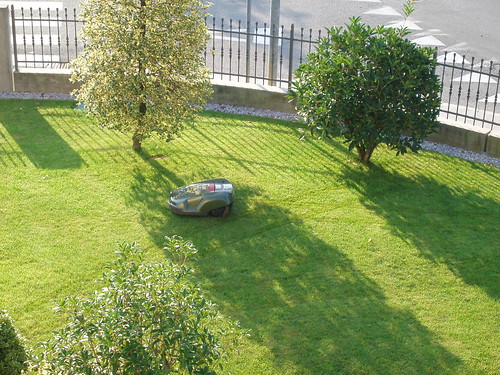
Above and below: The Automower in operation
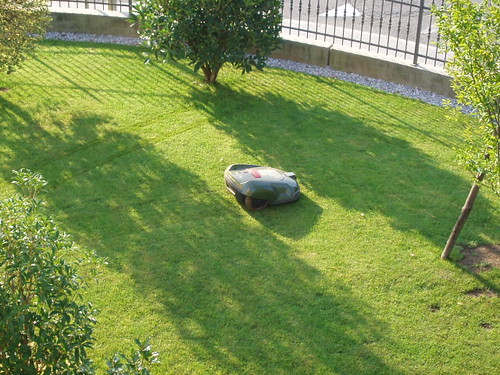
And this vacuum hole on the wall of each room:

When you open the black lid, it absorbs the air just like a Hoover. The holes are connected through pipes inside the walls to the vacuum machine in the car garage. So you only need to connect a vacuum tube to the hole to clean each room. You don't need to carry a heavy Hoover from one room to another. You don't need to disentangle an electric cable while and after vacuuming. I haven't seen this in technologically most developed Tokyo, let alone in technologically less developed London. Well, more precisely, what Japanese are good at is electronics technology. Italians are better at mechanical technology. Britons are awkward with fancy technology.
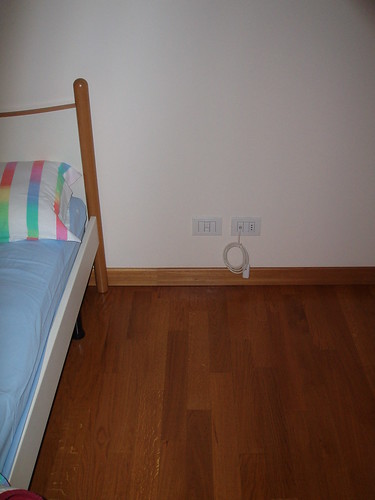
Finally, a bedroom where I stayed has a light switch attached to a cable from the wall (see the picture on the right) so that I didn't need to walk in the darkness after switching off the light.
Enough with Alberto's place. During my stay, I visited several towns in this northeastern part of Italy (mainly the region of Veneto). First, of course, Venice or
Venezia in Italian. This is the most disgustingly touristy city in the world. True, its landscape is enormously unique. There's no car running - all streets are narrow alleyways. Boats are the means of transportation. Water buses (called
vaporetto - there are even "nightbuses") and boat taxis are running across the city. Construction workers use a crane boat, not a crane car. The view from Canal Grande - an S-shaped, wide canal going through the centre of Venice - is amazing. Venetian glass is stunningly beautiful. (
See some pictures of Venice that I took if you dare - Everybody takes pictures in Venice. So these photos are not a big deal at all).
But 90% of the people you see are tourists - from Westerners to Chinese. Locals are all selling goods and services to them or hiding in the backstreets away from tourists. The city is basically dead - the population is in decline as housing cost keeps soaring. Most houses seem to be empty. Some rich people buy these houses just for using them once or twice a year to throw a gorgeous party.
Entrance to any public toilets costs one euro. The seaside is packed with tourists and souvenir shops including dodgy brand bag sellers (I saw Louis Vuitton bags with prints of red cherries). I couldn't relax by sitting at the seaside at all, though the sea itself looked beautiful. The worst is Piazza San Marco, the main square of the city, where I saw a horribly huge number of pigeons in the square - much more than in the Trafalgar Square in London! And I paid 12.50 euro for caffe latte at Caffe Florian, a very old cafe - since 1720 and frequented by many celebrities - facing Piazza San Marco. The price on the menu was 7.50 euro. It's already pricey, but I went for it given its historical significance. But when I got the bill, it said 12.50 euro. 7.50 euro for caffe latte (which was actually excellent - they served in a pot so I had three cups of it) and 5 euro for MUSIC! Outside the cafe there were some musicians playing mediocre classical music. If it were the table charge, it wouldn't be so outrageous, given its historical significance. But it was for unsolicited crappy music performance outside the cafe!
I realised that if you want tranquility in this city, you have to go to the east of Arsenale - the eastern tip of the main island is much more quiet. Murano, an island to the north (20 minutes by boat) famous for its glass works -
Dale Chihuly (see
30th July) studied glassblowing here - is another option. I saw a glass worker making a glass horse in a factory. His skill was amazing. During just a few minutes after taking out glass from a furnace and before glass cools down completely, this guy quickly molds heated glass into a horse by using numerous tools one after next. I bought a very beautiful piece of glasswork for 20 euro.
Aside from Venice, I visited Trieste, Caorle, and Treviso. Trieste, the easternmost city in Italy, next to Slovenia, was not worth visiting at all though lunch at Audace Cafe, a cafe facing Piazza di Unita d'Italia (the city's main square), was wonderful.
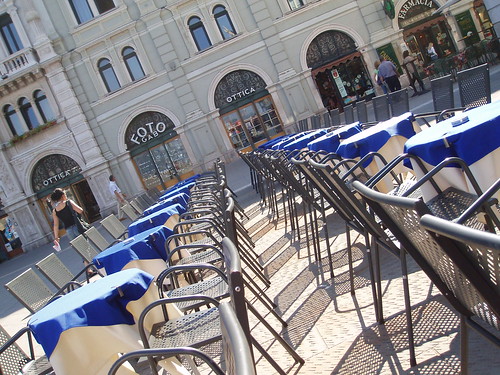
Above: Tables outdoors at Audace Cafe, on the Piazza di Unita d'Italia of Trieste. Below: San Guiusto cathedral, on the hill of Trieste.
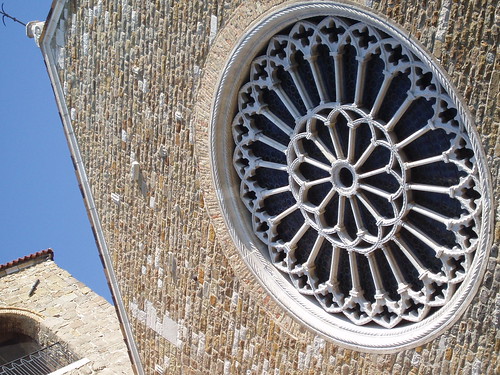
Plus I managed to experience the infamous delay of Italian railways on the way to Trieste - the train delayed 65 minutes and I took the next train that came first. How can you delay more than the next train?
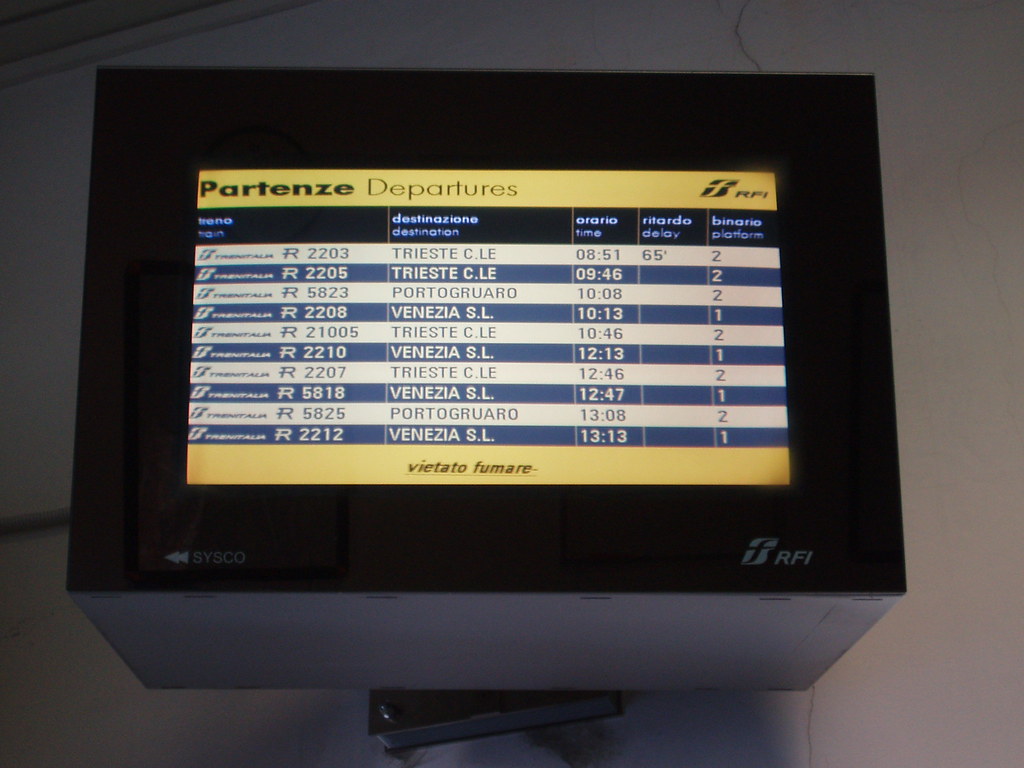
Above: A monitor screen at the waiting room of San Dona di Piave railway station (click the picture to enlarge). Look at the first and second rows. The first train to Trieste Centrale, scheduled at 0851, delayed 65 minutes. The next train came on time at 0946.
Caorle is a seaside town to the northeast of Venice. According to Alberto, this is where the elderly prefer to come. That's why the town has managed to avoid becoming tacky - for a seaside town it is surprisingly relaxing and tranquil. At a cafe I had a glass of
sgroppini - cold drink made of icecream, lemon juice, and vodka. I found there was no decent soft drink in Italy except for coffee - almost every drink contains alcohol. I was surprised to know there is no Italian law prohibiting young people from drinking. At the age of around 13, every Italian starts drinking.
And Treviso. We visited this town after dark. It's got this beautiful, contemporary-designed bridge.
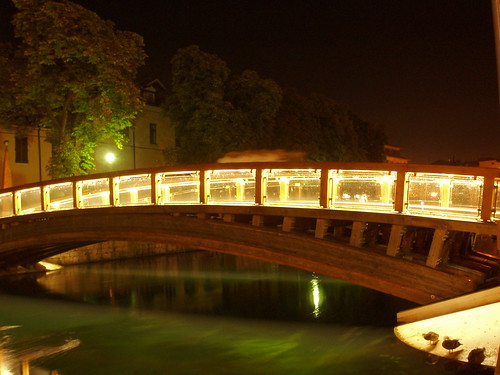
Near this bridge was, though, a London-style tacky bar - trying to be stylish not so successfully, with loud music pumped out from crappy sound systems, and full of smoking and alcohol smells. Well, this is a bar in a small town. You shouldn't expect that much.
But this bar was rather an exception than the rule. Caorle, Treviso, Oderzo, and San Dona (a town with the nearest railway station from Alberto's house) all have pleasant townscapes. Plus girls walking around in these towns are not dowdy at all. This is very surprising. If you visit a small town in Japan, you can't expect any girls stylish or attractive in a sophisticated way. Even in Osaka or Nagoya, a city with more than 50 million people, girls' fashion is clearly less impressive than in Tokyo. In London, except for in nightclubs, girls are not stylish - or slender - at all.
And Italian foods. They were tasty, of course. Naturally, I didn't want to go back to London in this sense. But there are a couple of things I couldn't stand about the Italian way of eating. First, they don't eat breakfast. They just have a cup of coffee and some chocolate cookies. How can they work properly in the morning with their stomach almost empty? Even England is better in this respect - it boasts the best English food - English breakfast.
The other thing I can't stand is that Italians eat delicious dishes but only one or two per meal. At one dinner, Alberto took me to a
ristorante. He explained the Italian style of dinner -
antipasto,
primo piatto (the first dish - usually pasta),
secondo piatto (the second dish - meat or fish), and side dishes like salad. He warned that each plate has a large amount of food. But I wanted to try a wide variety of meals. So I ignored his warning. I ended up unable to finish delicious beef steak as
secondo piatto. For another dinner, we went to a pizzeria. Each of us ordered one pizza. I wanted to share so that I could taste two different piazzas. Alberto didn't want that. He wanted to eat the whole pizza. I remembered when I went to
Strada, London's best - Alberto don't agree, though - pizzeria chain, with three Italian colleagues at LSE, I asked them to share each other's pizza. One of them didn't want that while the others reluctantly agreed to my suggestion. I now understood their reaction. (So I apologize for my insensitiveness to Italian culture - Riccardo, Rocco, and Barbara.) But I don't get it. Even the most delicious food loses its tastiness if you keep eating it. As typified in
kaiseki ryori (very expensive Japanese dinner where one very small dish after another is served almost endlessly), Japanese people like to taste a wide variety of meals at dinner. Italians don't get this. Or, if I use an economics jargon, their marginal utility from eating the same dish is very slowly diminishing.
But a good thing about eating out in Italy is that everytime Alberto said it was expensive, as soon as I converted the price into the British pounds, I said, "Not too bad at all!" My sense of fair prices has got totally screwed up in London.
Finally, one surprising thing to me was the rural landscape in Veneto looked very much like Japan! Although there was no rice field in this part of Italy, natural landscape looked very familiar to me.
On the way back to London, the degree of pleasure gradually declined. After checking-in at Treviso Airport, the world's second smallest airport (not sure if it's true, but as Alberto knew one smaller airport in Australia, we concluded that this was the second smallest), we went to a bar across the road. Serving at the bar counter were two Chinese people. Alberto told me they bought this bar from an old Italian family just before the low-cost airlines - EasyJet and Ryanair - started using the airport to carry passengers from and to London. As the airport had no drinking facility, this bar became very popular. I ordered caffe latte. My last coffee in Italy was basically made by a Chinese guy, which wasn't tasty at all.
I arrived at London Luton Airport at 2345, 10 minutes ahead of the schedule. At immigration, I waited for 45 minutes, watching EU nationals from the same airplane and the next airplane passed the passport check swiftly. (There were three immigration officers working, one for non-EU nationals and two for EU nationals though the time taken per person is much shorter for EU nationals.)
The train service (Thameslink) to central London was already over. I took a coach (Green Line) to Victoria for one hour. When I arrived there, the nightbus to my place was just gone. I waited for the next bus for 30 minutes under the freezing weather - it's already winter in London - and surrounded by rubbish spread around on the ground. I'm back in London.
Let me finally show you a picture of the most desired souvenir of Italy: David's trunks. (I always think that Michelangelo's David was made for gay men at that time.)
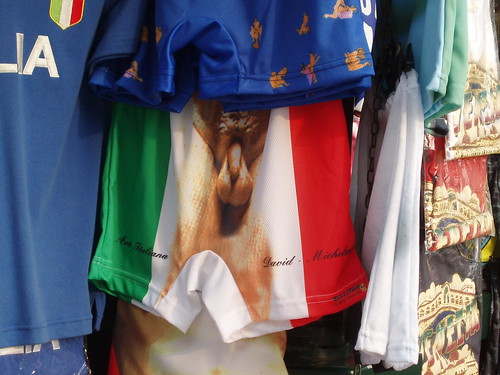



 Finally, a bedroom where I stayed has a light switch attached to a cable from the wall (see the picture on the right) so that I didn't need to walk in the darkness after switching off the light.
Finally, a bedroom where I stayed has a light switch attached to a cable from the wall (see the picture on the right) so that I didn't need to walk in the darkness after switching off the light.



